Our Amazon Jungle Tour from Iquitos: Mud, Monkeys, and Munching on Piranha
- Rand Blimes

- Jun 23
- 17 min read
Updated: Jun 25

Amazon Jungle Tour from Iquitos: Why You Need to Go Beyond the City
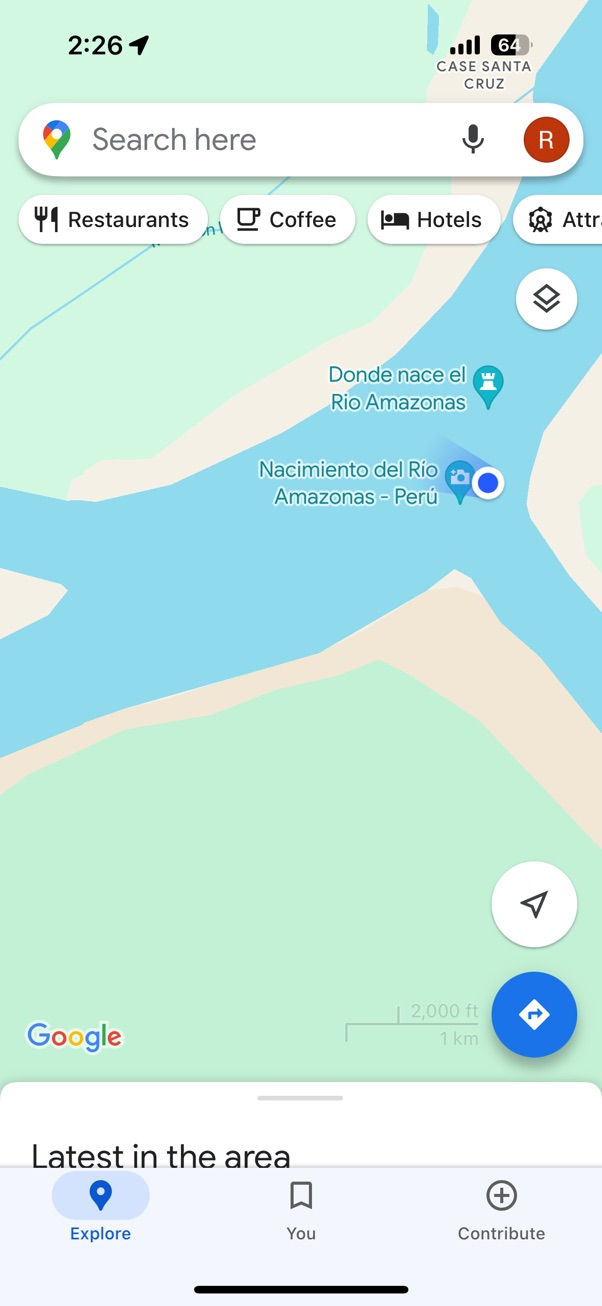
My favorite city in the jungle, Iquitos, is technically in the Amazon — but it’s not, like, IN the Amazon. It’s a full-on city. Cities mean people, and people mean hunting and habitat loss. So unless you’re really into spotting pigeons and the occasional parrot, don’t expect to see much wildlife near the city (with the delightful exception of Isla de los Monos, which I wrote about here).
If you want to see squirrel monkeys swinging through the trees, pygmy marmosets foraging in the canopy, or caimans sunning themselves along the riverbanks, you’ve got to get out. Far out. The farther from Iquitos you go, the better your odds.
The most common (and frankly, best) way to do that is to book a jungle lodge package. These usually include roundtrip transport from Iquitos, lodging, meals, and daily excursions into the jungle. While there are tour offices in Iquitos where you can book in person, almost everyone we met had reserved ahead of time — and that’s what we did too.
We booked a four-day, three-night tour through Allpayacu Adventures ($720 for two people in 2024), and it was fantastic. Details below — including airborne fish, biting ants, and a whole lot of monkey magic.

Choosing Your Lodge: Distance, Comfort, and Tarantula Roommates
To choose your lodge, there are a few things you need to consider.
First, go as far away from Iquitos as your budget — and your tolerance for long travel days — will allow. Our tour began with a two-hour drive to the “town” of Nauta, a riverside jumble of buildings, markets, and boats. From there, we took a boat for several more hours, first along the Amazon itself, and then up a small tributary to our lodge. It was remote enough that the jungle was teeming with monkeys and birds, and sloths were common enough. But don’t expect jaguars or tapirs — there just aren’t enough untouched habitats left near human settlements. We also didn’t see any snakes, though that may have been pure luck or disappointment depending on your personal snake philosophy.


Second, choose your comfort level. We stayed at a relatively simple lodge. Think: plywood cabins with mosquito nets. No hot water (which you only miss briefly in the chilly mornings), a few hours of electricity in the evening (just enough to charge your phone), and simple but very tasty meals. There was also a hammock room — “room” being generous, as it was an open-air space enclosed in mosquito netting — that housed a pet tarantula. He was shy. I gently touched his leg once, and he bolted like I’d just insulted his mother. If your lodge has a similar mascot, just remember to shake out the hammock before getting cozy.
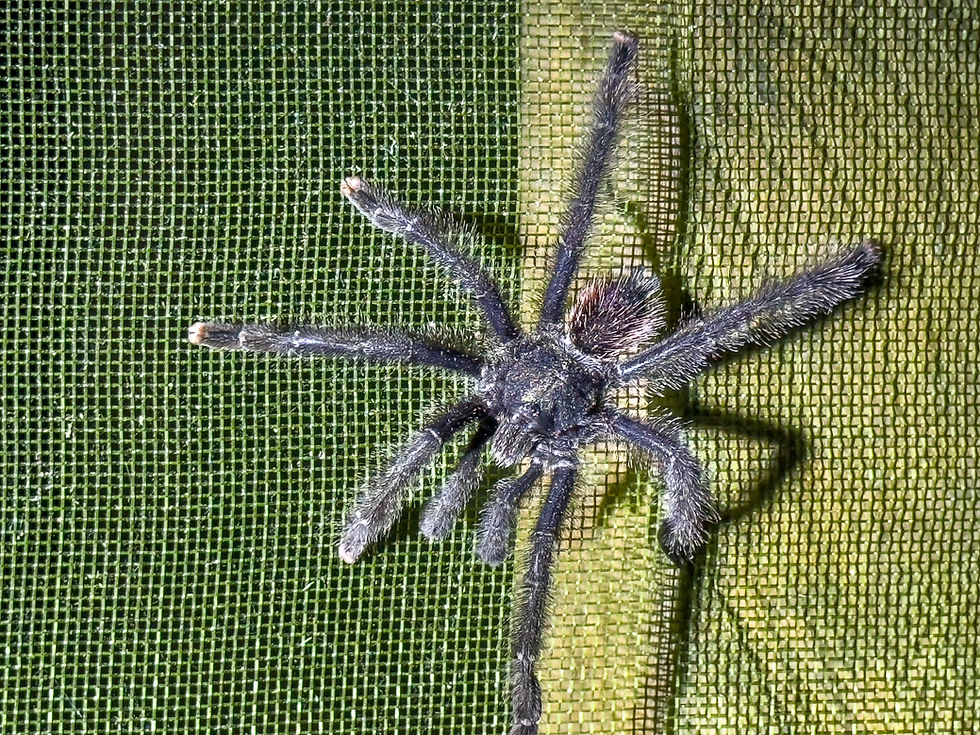
In theory, you can pay more for luxury. We passed lodges with entire fields of solar panels, which I assume means they had power all day. But honestly, when we weren’t hiking the jungle, cruising the tributaries, smearing mud on ourselves in a make-shift spa, or fishing for piranha, we were napping in hammocks. Electricity seemed pretty optional.
Personally, a certain amount of “roughing it” made the experience more memorable. Your mileage may vary.
Third, think about group size. My wife and I had a private tour, which meant we could change any part of the itinerary and always go at our own pace. You can save money by joining a group tour, though. And even with a private tour, you may end up sharing a boat occasionally if everyone’s headed to the same place.

Fourth, try to book with an operator that works with local communities and hires local guides, boat drivers, animal spotters, and cooks. Whether you care about sustainability and supporting local livelihoods, or you just want the most knowledgeable guides (who else knows the forest like the people who live in it?), either way, it’s a good decision.
Finally, pick a lodge with activities you actually want to do. Most jungle itineraries are pretty similar — what varies most is how many days you stay. More days = more excursions. Some tours offer an overnight camp in the jungle (we didn’t do this). Or if you are feeling psychedelic, you can add on a ayahuasca ceremony (we didn’t do this either). And be aware that the season matters: in the low-water season, you’ll do more hiking; in high-water season, more canoeing through flooded forests.
Below, I’ve listed the main activities we did — and honestly, they were all excellent.

Health and Safety: Jungle Perils and One Very Vengeful Ant
Let’s talk health and safety. You’re going into the Amazon jungle — a place with venomous snakes, biting insects, toothy fish, and the occasional crocodilian. So obviously, the thing that will probably get you is... an ant.
Despite swimming in the same waters where we had just been piranha fishing — and despite catching a live caiman with our bare hands (okay, technically the guide caught it, but we held it, and that counts!) — the most dangerous creature we encountered was a devious little orange ant. It snuck under my mosquito net during the night and spent a few hours casually mauling my ankles. I woke up to find both legs covered in itchy welts that lasted for nearly two weeks. Two weeks! Jungle justice is real, and apparently, it comes in six-legged form.
That said, here’s the actual safety breakdown:
Insects: The lodge provided mosquito nets, and we brought strong repellent, which we used daily. Overall, mosquito/insect trouble was minimal for us — except for the aforementioned saboteur. Long, light clothing helps. Also, we were there during the low water season.
Wildlife: The animals we encountered were wild but generally shy or slow-moving. Don’t try to pet things unless your guide says it’s okay. That said, caiman handling was surprisingly safe (and weirdly gentle — it was like holding a prehistoric balloon animal).
Water: We drank filtered water provided by the lodge. No issues. We also swam in the river, which sounds dramatic, but our guide gave the green light and no one got eaten.
Medical access: Once you’re out there, you’re out there. You’re hours away from a clinic. If you have a serious allergy or medical condition, talk to the tour operator first and pack accordingly. Our guide had a basic first-aid kit, but this is not the time to assume there’s a jungle ambulance on standby. Coming to the Amazon without travel insurance is risky living. Hope for the best, prepare for the worst.
General hygiene: You’ll get muddy. You’ll sweat. You’ll smell. And you’ll survive. We brought wet wipes and a sense of humor. Both were essential. And try to keep your fingers out of your mouth and eyes (and, I hope it goes without saying, keep your fingers out of other people's mouthes and eyes as well!).
Bottom line: the Amazon isn’t Disneyland — but with a good guide and common sense, it’s not a death trap either. Just keep your mosquito net tucked in, listen to your guide, and if you see a little orange ant heading your way, run.

Activities: What We Actually Did Out There
A trip to the Amazon isn't about checking off tourist sites. It’s about doing — drifting, hiking, paddling, swatting, swimming, spotting, sweating, gasping, and occasionally squealing. What follows is a rundown of the main activities we did during our four days in the jungle.
Looking for Pink and Gray River Dolphins

Freshwater river dolphins are the only brand of dolphin that is actively ugly. Not just not cute. These things are kind of terrifying. Like someone tried to build a dolphin out of modeling clay and got distracted halfway through. Long beak-like snouts, tiny eyes, humped backs — they’re like marine life filtered through a fever dream. But they’re still dolphins, and that means your soul is filled with joy when they’re around. Right?
There are two species in the Amazon basin: the pink river dolphin (Inia geoffrensis), known locally as the boto, and the gray river dolphin (Sotalia fluviatilis), sometimes called the tucuxi. The pink ones are particularly odd. They actually start off gray and turn pink as they age — possibly as a result of scar tissue from fighting and rough play. They're also unusually flexible due to unfused neck vertebrae, which lets them bend in ways ocean dolphins can’t. That’s right — they’re blobby, bendy river weirdos. And somehow, they’re wonderful.
We had tried looking for river dolphins once before on the Mekong. They’re famously elusive. You’ll stare at the water for forty minutes straight, until you start to go blind. So we were hoping to see one, but we weren’t really expecting to . . .
THERE’S ONE!!!
Wow! We weren’t even at the part of the tour where we were supposed to be looking for dolphins. We were just cruising down the river, and . . .
THERE’S ONE!!!
Wow. We are so lucky! I can’t believe—
THERE’S ONE!!!
Seriously, they were everywhere. Pink. Gray. Swimming slowly. Leaping. Humped backs and blunt heads rising and falling like dream-creatures from an Amazonian folktale.
We saw dolphins every day. Multiple times a day. None of them came particularly close to us while we were swimming, which is probably fine. Remember: these things are like dolphins that crawled out of the mind of Stephen King.
THERE’S ONE!!!
Boat Safaris
There are also plenty of boat trips looking for creatures other than river dolphins. Monkeys, birds, sloths, iguanas. And then there is the river scenery itself. Plan to spend a good deal of time in boats if you visit the Amazon.

Jungle Hiking

We did several different hikes in the jungle.
Part of the draw of a jungle hike is just… being in it. The sheer presence of it. Trees that stretch into forever. Humidity that clings to your skin like an overly affectionate ghost. Sounds you can’t identify and are probably happier not knowing. And then there’s your guide — who doesn’t just walk through the jungle, but inhabits it.
A good guide tells you stories about the plants. About the trees. About the vines and their uses and the ants and the fungus and the bark you probably shouldn’t touch. They’ll be standing in front of you, looking you dead in the eye mid-sentence — and suddenly, their head snaps left, eyes narrow, shoulders still. If you listen closely, you can almost hear the weight of their ancestry humming through the canopy.
Then, they point.

“Sloth.”
You look. You see… green. Leaves. Trees. Possibly an owl? Definitely not a sloth.
But your guide is patient. They beckon, and you follow, weaving through the thick underbrush. They step carefully over a highway of ants (note: do not step on the ant line unless you’re ready to do the itchy-leg dance for days). Then they stop. Point again.
“Sloth!”
You still do not see a sloth.
“See that tree?” they say.
What tree? There are 87,000 trees.
“No, that tree. The one kind of shaped like a spoon.” (???)
You maybe spot it. They nod encouragingly. “It’s not in that tree. But if you look at the branch that’s part of the way up that tree, then past that — sort of around that leaf — you’ll see another tree. It’s behind the trunk of that tree.”
Behind the trunk?? How do you know that??
“Well, you can’t really see the sloth,” they say. “But see that little curve there? That’s a claw. That’s its foot!”
A claw? A grayish-brown thing that’s the exact color of the tree bark? You saw that from 100 meters away? Through all this foliage? AROUND a leaf??
You accuse them — kindly — of leg-pulling.
They calmly set up a tripod, adjust the binoculars, train them out into the void, and invite you to look.
And sure enough… right there… is a freaking claw.
Barely visible even with magnification and a verbal roadmap, but there it is. A claw. And behind it, somewhere in the leafy obscurity, is the rest of a sloth — presumably. It’s astonishing. And it’s why you go with a company that hires local guides who have Jedi jungle vision.
Luckily, not everything was that hard to spot.

Pygmy marmosets — one of my all-time favorite animals — were much more generous. We spotted a mated pair going about their business: foraging for insects, scampering around the trunks, occasionally pausing to give us the side-eye. Pygmy marmosets have been a favorite of mine since I was a kid watching them in the zoo, and seeing them up close in the wild was pure magic. Also, they eat bugs, which instantly elevates them in my esteem.
And then — squirrel monkeys. A whole troop. At least forty of them, bouncing through the trees like little acrobats in a jungle circus. Playing, eating, watching us watch them. For someone who considers “monkey enthusiast” a core part of his identity, this was a peak life moment.

The hike itself wasn’t too difficult. Sure, it was hot and humid (because: jungle), but the terrain was mostly flat. We strolled under towering trees, gawked at giant vines, and completely lost our composure over the world’s cutest monkeys.
Would do again in a heartbeat. Even if I didn’t get to see the full sloth.
(But I did see the claw. So that’s something.)
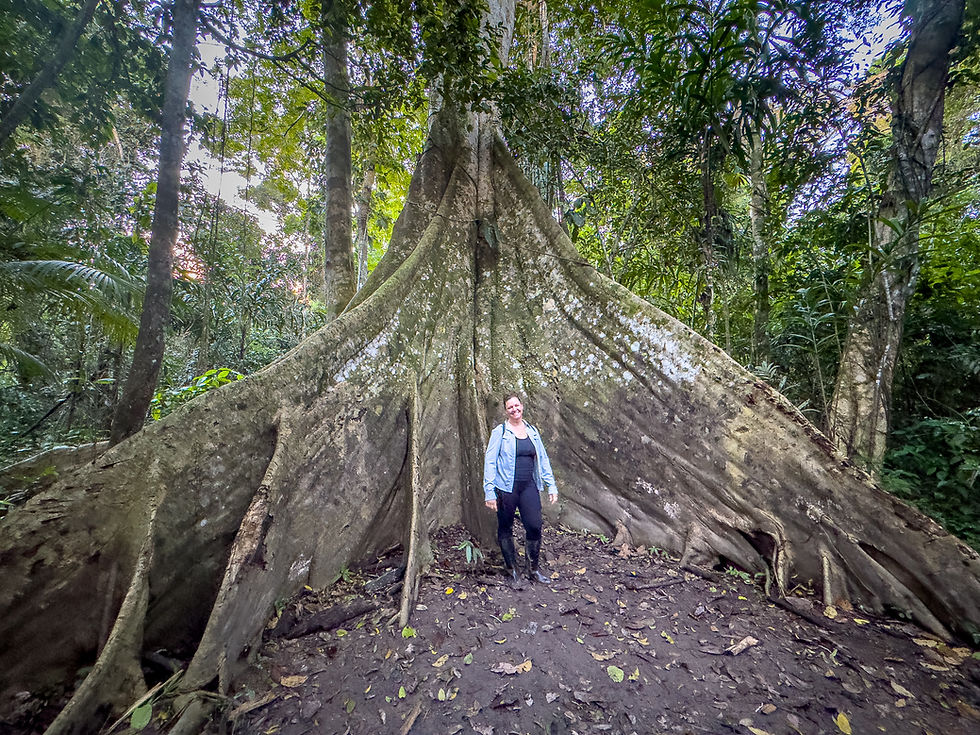
Night Hiking
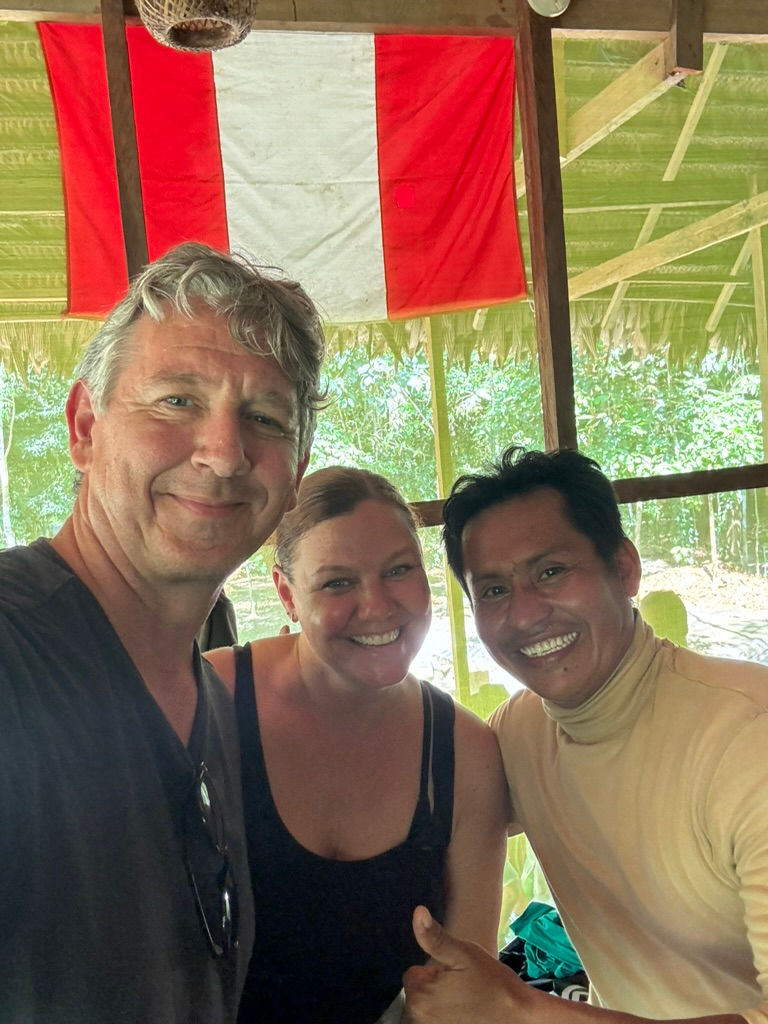
“Oh, we need to keep moving. Quickly.”
Not the words you want to hear in the jungle at night.
We followed the guide, walking as quickly as one can walk through dense undergrowth in pitch blackness while trying not to fall into a tangle of roots, branches, or large nocturnal eyeballs. Only later did he explain — rather calmly, in hindsight — that his flashlight had attracted a wasp. Not just any wasp. A wasp that, if it decided to sting one of us, would send us straight to the hospital. Let's just call it a death-wasp.
So yes, we moved quickly.
Fortunately, we escaped the death-wasp without incident and continued deeper into the darkness. The only light came from our guide’s flashlight and, occasionally, the feeble beams from our phones — though we used those sparingly. Electricity is scarce in the Amazon, and phone batteries disappear faster than your courage when you see your first tarantula.
To be clear: the night hike was not a serene moonlit stroll. It was a guided descent into every creepy-crawly fear you’ve ever had. The jungle comes alive at night — and not in a Disney way.
Massive spiders. Scorpions. Strange clicking sounds. Things that rustled, slithered, and crawled. The forest floor was a tangle of roots and leaves, but your real focus was up — because if you were the tallest in your group (as I was), you were going to walk face-first into a spiderweb the size of a badminton net. With a spider in the middle roughly the size of a dinner plate.

Also: wear the galoshes your lodge gives you. Not optional. They keep you dry and (mostly) bug-free, and they give you just enough confidence to pretend the thing brushing your leg was a leaf and not a nocturnal horror with fangs.
Also also: wear DEET. Liberally. Then wear some more. Then apologize to the environment and wear it again.
And yet... it was kind of incredible. Everything felt alive, breathing, watching. The way the guide would freeze, point, and suddenly reveal something perfectly camouflaged — a frog on a tree, a spider with glistening eyes like beads of terror — was, in its own terrifying way, magical.
The jungle at night is not for the faint of heart. But it is unforgettable.
And once you’ve survived the death-wasp, everything else is just... ambiance.
Night boat ride

Imagine this: you’re sitting in a small boat, gliding gently through a narrow river in the dead of night. The sky above is layered with stars so thick and bright that at first you think you're looking at clouds — but no, it's the Milky Way, stretched across the sky like a glowing river of its own. Everything is calm. Still. Magical.
And then — whack! — a fish hits you in the chest.
Turns out, some Amazon fish have a charming habit of leaping out of the water at night. Combine that with a moving boat, and there’s a non-zero chance you’ll collide midair. I was the only one in our group to actually get smacked in the torso by a flying fish, but a couple of others landed in the bottom of the boat — which we discovered only when they started flopping around by our feet. We scooped them up and tossed them back into the river, which felt like the right thing to do. (Especially since we hadn’t paid for the “catch your own dinner with your sternum” package.)
Somewhere between ducking fish and scanning the stars, we also spotted caimans — those prehistoric, half-submerged eyes along the riverbank. Most just watched us silently, glowing faintly under the flashlight beam.
And then there was one that didn’t get to stay mysterious.
Our guide, seeing one on the shore, casually stepped out of the boat and grabbed it. Just plucked it off the edge of the river like someone retrieving a lost flip-flop. It was a small one — and yes, cute, in that scaley, toothy way that makes you want to pet it and also take three steps back.
We held it for a few moments, its little jaws ready to snap down on anything opportunity presented. We admired its prehistoric charm, and then let it slip back into the water like nothing had happened.
It was the kind of surreal, hilarious, quietly beautiful experience that only the Amazon could deliver. Stars above, fish below, and a caiman in hand. Welcome to the jungle.
Piranha Fishing
I grew up in the 80s, back when nature’s two favorite ways of killing off movie characters were 1) quicksand, and 2) piranha swarms. You know the scene: someone’s swimming happily in an otherwise serene jungle river. Music swells. Cut to flashing silver bodies and razor teeth. A twinge of pain in the toe — “Hey! Something bit me!” — and seconds later, the camera pans to a floating skeleton. Classic.

So there was a certain sense of poetic justice when I slid a chunk of raw meat onto my hook and lowered it into the water from our small boat. The tables had turned, piranha! I was now the predator. I was going to catch you... and devour you. (Insert maniacal laughter.)
But alas, it turns out that piranha are smarter than I am.
In about an hour of dedicated fishing, I didn’t catch a single one. What I did do, quite successfully, was feed them. I’d bait the hook, lower it in, wait a few seconds, and pull up a naked hook — the meat vanished, the fish unfazed. Somewhere beneath the surface, I’m pretty sure a chorus of piranha were laughing. “Haha, stupid human! We see your hook. We eat your bait. We live!” (Maniacal fish laughter bubbles to the surface.)
To set the record straight: piranhas get a bad rap. Decades of cartoons, horror movies, and shaky science have cast them as bloodthirsty river demons. But in reality, they’re just... fish. Fish with teeth, yes, but mostly scavengers. They’re omnivores, they spook easily, and while they can bite, they’d rather nibble a carcass than go after your wiggling toes. They’re sharp-toothed hype victims, nothing more.
In our time spent fishing, the local guides pulled in several piranha with impressive ease. My wife and I? Nada. (Note: I’m more of a spear fisherman at home. Rod and reel are not my natural weapons. If you fish, you may do better.)
We took the fish back to the lodge, and the kitchen crew fried them up for lunch. And I can now report, definitively: piranha are mostly bone. You get a few bites of meat, but if you were planning on eating your fill, bring snacks. They’re more teeth than fillet.

Swimming and a Mud Spa
To review: I grew up in the 80s, back when nature’s two favorite ways of killing off movie characters were 1) quicksand, and 2) piranha swarms. So diving into the Amazon River for a refreshing swim required a solid dose of “mind over matter.” I knew the whole “instant skeleton” piranha trope was fiction... but knowing you’re safe and believing you’re safe are two very different things.

Still, it was a hot day. The guides jumped right in. Then my wife followed. And at that point, pride demanded that I go too. So I dove in — and once you’re submerged in the world’s greatest river, you kind of forget to feel your skin crawling in anticipation of being devoured one tiny bite at a time.
We swam in the main river, not the smaller tributaries. That meant more space to splash around, but also a strong current — so we stayed close to shore where the water was calmer (and where our guides wouldn’t need to rescue us with the boat if we got swept away like jungle debris).
We had seen river dolphins in that area earlier, so we kept an eye out, hoping for a magical close encounter. And we did see a few — but not nearby. No dolphins joined us for synchronized swimming.
Afterward, the guides told us that many believe Amazon river mud has healing properties for your skin. So naturally, we embraced the chance to do something ridiculous and wonderful: we slathered ourselves in thick, clay-rich mud and sat on the riverbank while it dried like the world’s most remote spa treatment.
I can’t say if it improved my skin. But as a fully grown adult with permission to coat myself head to toe in river mud and bask in the sun like a feral toddler... it was fantastic. I don’t know if it helped my skin, but it definitely did something good for my soul.


What to Bring
Packing for the Amazon isn’t complicated — but it’s not forgiving either. If you forget something essential, you’re not going to find it at a jungle kiosk. Our tour operator gave us a solid list, and after doing the trip, I can confirm: they knew what they were talking about. Here’s what you’ll want to bring:
Long-sleeved shirts and long pants (preferably loose and light-colored) – for sun protection and keeping the bugs at bay. Additionally, you need to protect yourself from thorns and stuff that will make you itch on jungle hikes. That means wearing long pants and long sleeves while hiking through the hot, humid jungle. Bring something that covers, but won’t make you overheat.
Swimsuit – optional, but highly recommended if you want to say you’ve swum in the Amazon
Towel – not all lodges provide them (ours did), and you’ll want one after swimming and showers, or for sweat-mop duty
Mosquito repellent (spray preferred) – your survival and sanity may depend on it
Sunscreen – the kind that doesn’t immediately vanish when you sweat (because you will sweat). While you are shaded from the sun in the jungle, you will be exposed on smaller boats (larger boats tend to have canopies)
Sunglasses – you’ll be on open water under fierce sunlight
Hat or cap – ideally something with a brim that won’t fly off in the boat
Flashlight or headlamp – useful for night hikes and power outages. We got by with our phone lights (even thought we used them as little as possible to conserve battery power)
Power bank(s) – I use too much camera equipment to not view these as critical in a place with limited electricity
Camera – or phone with enough memory and juice to document all the magic
Refillable water bottle – most lodges offer filtered water, so skip the single-use plastics
Comfortable walking shoes – sneakers are fine for boats and dry ground. My wife and I just stuck to flip-flops (which are our go to footwear at home)
Rubber boots – these will usually be provided by the lodge for jungle hikes
Cash – small bills for tips, souvenirs, or buying an emergency bottle of Coke from the lodge. There are no ATMs in the jungle
You don’t need to overpack — in fact, you shouldn’t — but don’t skimp on the essentials. The Amazon is not interested in whether you brought the right shoes. But your feet will be.
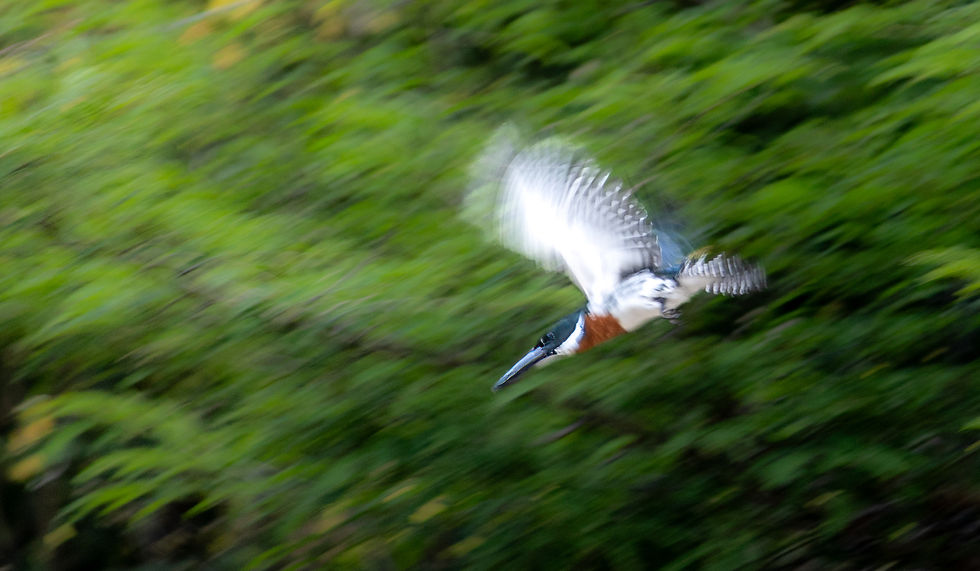

Final Thoughts
I had always dreamed of the Amazon — and, like most dreams, mine involved a heavy dose of fiction: piranha swarms, snake attacks, maybe an ancient ruin or two hidden under vines. What we actually got on our Amazon jungle tour from Iquitos was so much better. We got monkey sightings and sloth claws, night walks under spider-laced canopies, river swims in legendary waters, and fish that launched themselves into our boat. We got heat and mud and laughter and moments of awe that snuck up on us between the sweating and the bug repellent.
And, because travel has a way of re-teaching you the basics, we also got reminded — again — that real adventure just needs to be real. The jungle doesn't care how many nature documentaries you’ve watched. It humbles you, delights you, hides things from you, and — if you’re lucky — reveals just enough to make you feel like you’ve stepped into something older and wilder than anywhere you have been before.
Video of our Amazon jungle trip part 1
Video of our Amazon jungle trip part 2



Comments